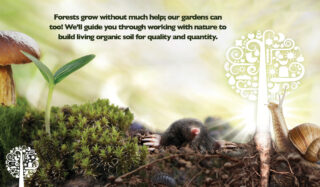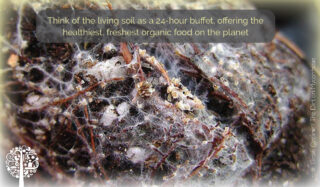Grow Your Best Crops With Nature’s Helping Hand And Living Organic Soil
Why do we grow our food? Most growers will say for quality, flavour, and freshness, and to achieve those things, they experiment with different growing systems, nutrient regimes, environmental controls, lighting methods, and plant genetics. This often represents a lifelong journey of experimenting, tweaking, and trying new knowledge and technology.

But apart from some notable improvements in lighting technology, some growers argue that not much has changed in the last 20 years. Perhaps, that makes us all the more ready and willing to embrace a new concept that can take us to the next level in this new age of indoor cultivation.
Lost Skills
Until recently, there has been less inclination to grow food at home, and because of that, essential skills and knowledge have been lost. How many growers have a personal composting system, save their seeds, and tend their soil themselves? Instead, it has become the norm to grow in small pots that we supplement with an array of liquid feeds and additives.
In the last few years, there has been an uprising based on the discovery that the vast majority of plants can grow perfectly well without our help! All they need is good soil and the proper environmental conditions to thrive. Plain water and minimal inputs are delivered to larger volumes of high-quality soil; no bottled feeding regimes are required. Some gardeners are reusing their soil repeatedly rather than replacing it with a fresh pile every year. This approach is cost-effective and grows healthy and productive plants. It also attempts to recreate the outdoors in an indoor environment, working with nature to let plants pretty much grow themselves!
Living Organics
This new wave of indoor organic purists use terms like ‘no-till’ and ‘living organics’ to describe practices focusing on more sustainable ways to grow while achieving superior results. They understand that more work at the beginning builds good quality soil, and then nature is left to cycle the nutrients and make them available to the plants in the future. The concept is relatively new to indoor growers, but it’s gaining massive momentum in the U.S. and will soon dominate large portions of the international market.
Providing that the soil has been adequately made, it contains everything a plant needs from seedling until harvest, except water. Of course, many additional inputs can be used, but they are often unnecessary. Specialist companies focusing on the needs of this new market are only now beginning to establish themselves, making it possible for growers to get everything they need in one place and pre-made soil mixes.
The Right Containers
Pot size is a critical difference between living soil and traditional bottle-fed growing. Four plants can be grown in a square meter with 15-20L pots when feeding with liquids. But when using living soil, four 40-50L pots per metre are recommended. The larger volume of the earth allows for a reserve of nutrients to sustain the plant through its cycle. A plant will always be happier if it has more space for root development, and if the soil is healthy with good microbial activity and nutrients, they don’t need anything else but water. Consider the forest for a moment; who is feeding that? The same idea applies to indoor gardens. We must relearn what we’ve forgotten and let nature do its thing!
Generally, living soil growers prefer fabric pots, allowing air pruning of the roots around the sides and helping maintain moisture levels. Some gardens use large beds and sow multiple plants in each to get the increased benefits from the mycorrhizal network. With this soil volume, growers only need to focus on water, ensuring the earth is never too dry or too wet. The microbial life within the soil will continue to develop and diversify, and the plant will take up every nutrient it needs.
Your Focus
When the soil moisture and pot size are just right, growers need only to maintain the canopy, prune lower growth, and inspect for pests or damage. Think of the living soil as a 24-hour buffet offering the healthiest, freshest organic food. There is no need to force feed, as when using mineral nutrients. With healthy living soils, plants grow themselves if the soil inputs are well balanced.

Better yet, yield doesn’t have to be a trade-off for superior quality. Plants can quickly reach their full potential when they have all their nutritional requirements. Their immune systems are healthy, they have a much higher nutrient density and BRIX level, and their essential oils, terpenes, and flavonoids can develop fully. They have more vigour and energy and can withstand stress much better. It is possible to achieve the same yields with organics as any other growing method.
Maintaining proper soil health also increases soil respiration. The soil microbial life consumes oxygen and produces carbon dioxide. With the organic soil inputs continually being broken down by microbes, there is a steady release of CO2 from the soil to benefit further the plant – your living and breathing ecosystem in a pot!

No-Till, No-Waste
You can also develop a no-till system which reuses the same soil without remixing for every grow. Plant waste material from pruning can be used to feed the next crop and develop a recycling system where nothing leaves the grow room other than finished produce. Note that recycling the soil requires further enhancement, such as the addition of worms and a mulch layer, but it is the ultimate in self-sufficiency, closed loop, and sustainable indoor gardening.
Using living soils for one single grow is also great because it is much easier to get started. It is never recommended to use pots smaller than 20L and know that some supplementation may still be required with lower soil volume. However, look at it as feeding the soil, not the plant. Some instant teas, top dresses, foliar sprays, or soil drenches are easy ways to get good nutrition into the soil to keep everything green and healthy. Now, kits are available that cover the full range of soil amendments.
In future editions, we will discuss in more detail the way the living soil works and what it contains, what growers need to do, the best practice for watering, and also share some real-world examples of living soil in action in home gardens and large-scale commercial facilities.




